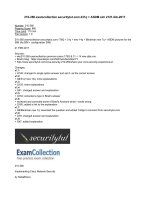2007 02 01b janecek perceptron kho tài liệu bách khoa
Bạn đang xem bản rút gọn của tài liệu. Xem và tải ngay bản đầy đủ của tài liệu tại đây (475.23 KB, 37 trang )
The Simple Perceptron
Artificial Neural Network
●
●
●
●
Information processing architecture loosely
modelled on the brain
Consist of a large number of interconnected
processing units (neurons)
Work in parallel to accomplish a global task
Generally used to model relationships between
inputs and outputs or find patterns in data
Artificial Neural Network
●
3 Types of layers
Single Processing Unit
Activation Functions
●
Function which takes the total input and
produces an output for the node given some
threshold.
Network Structure
●
Two main network structures
1. Feed-Forward
Network
2. Recurrent
Network
Network Structure
●
Two main network structures
1. Feed-Forward
Network
2. Recurrent
Network
Learning Paradigms
●
Supervised Learning:
Given training data consisting of pairs of
inputs/outputs, find a function which correctly
matches them
●
Unsupervised Learning:
Given a data set, the network finds patterns and
categorizes into data groups.
●
Reinforcement Learning:
No data given. Agent interacts with the
environment calculating cost of actions.
Simple Perceptron
●
The perceptron is a single layer feed-forward
neural network.
Simple Perceptron
●
●
Simplest output function
Used to classify patterns said to be linearly
separable
Linearly Separable
Linearly Separable
The bias is proportional to the offset of the plane
from the origin
The weights determine the slope of the line
The weight vector
is perpendicular to
the plane
Perceptron Learning Algorithm
●
●
●
We want to train the perceptron to classify
inputs correctly
Accomplished by adjusting the connecting
weights and the bias
Can only properly handle linearly separable
sets
Perceptron Learning Algorithm
●
●
●
●
We have a “training set” which is a set of input
vectors used to train the perceptron.
During training both wi and θ (bias) are modified
for convenience, let w0 = θ and x0 = 1
Let, η, the learning rate, be a small positive
number (small steps lessen the possibility of
destroying correct classifications)
Initialise wi to some values
Perceptron Learning Algorithm
Desired output
{
1
if
x
n∈set
A
d n =
−1 if x n∈set B
1. Select random sample from training set as input
2. If classification is correct, do nothing
3. If classification is incorrect, modify the weight
vector w using
w i =w i ηd n x i n
Repeat this procedure until the entire training set
is classified correctly
Learning Example
Initial Values:
η = 0.2
0
w= 1
0.5
0 = w 0w 1 x1w 2 x 2
= 0x 10.5x 2
⇒ x 2 = −2x1
Learning Example
η = 0.2
0
w= 1
0.5
x1 = 1, x2 = 1
wTx > 0
Correct classification,
no action
Learning Example
η = 0.2
0
w= 1
0.5
x1 = 2, x2 = -2
w 0 = w 0−0.2∗1
w 1 = w 1−0.2∗2
w 2 = w 2−0.2∗−2
Learning Example
η = 0.2
−0.2
w = 0.6
0.9
x1 = 2, x2 = -2
w 0 = w 0−0.2∗1
w 1 = w 1−0.2∗2
w 2 = w 2−0.2∗−2
Learning Example
η = 0.2
−0.2
w = 0.6
0.9
x1 = -1, x2 = -1.5
wTx < 0
Correct classification,
no action
Learning Example
η = 0.2
−0.2
w = 0.6
0.9
x1 = -2, x2 = -1
wTx < 0
Correct classification,
no action
Learning Example
η = 0.2
−0.2
w = 0.6
0.9
x1 = -2, x2 = 1
w 0 = w 00.2∗1
w 1 = w 10.2∗−2
w 2 = w 20.2∗1
Learning Example
η = 0.2
0
w = 0.2
1.1
x1 = -2, x2 = 1
w 0 = w 00.2∗1
w 1 = w 10.2∗−2
w 2 = w 20.2∗1
Learning Example
η = 0.2
0
w = 0.2
1.1
x1 = 1.5, x2 = -0.5
w 0 = w 00.2∗1
w 1 = w 10.2∗1.5
w 2 = w 20.2∗−0.5
Learning Example
η = 0.2
0.2
w = 0.5
1
x1 = 1.5, x2 = -0.5
w 0 = w 00.2∗1
w 1 = w 10.2∗1.5
w 2 = w 20.2∗−0.5









